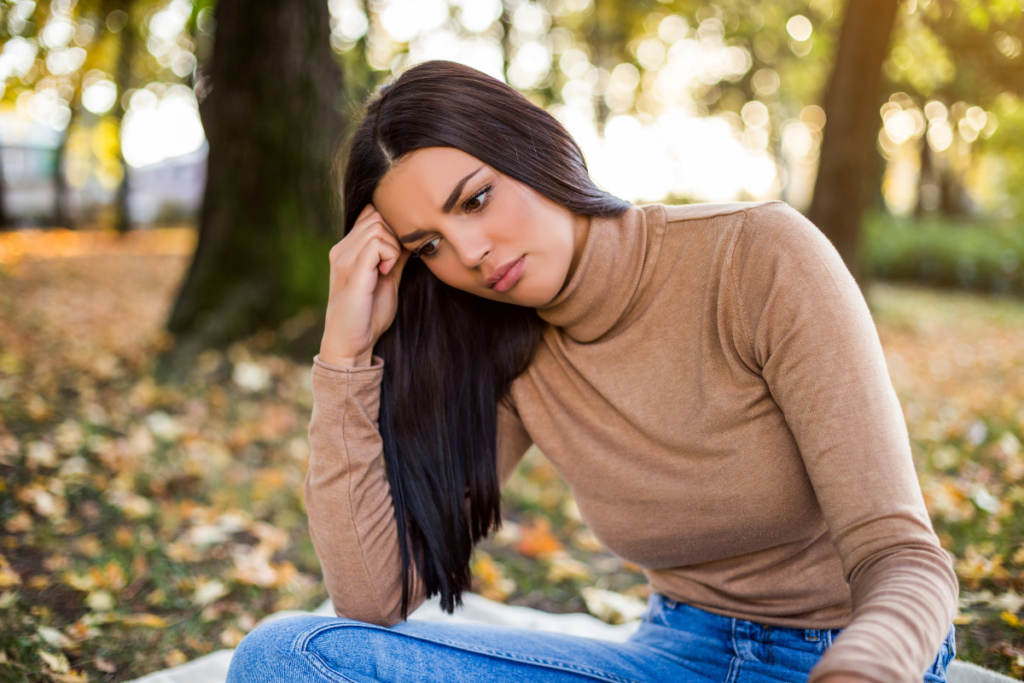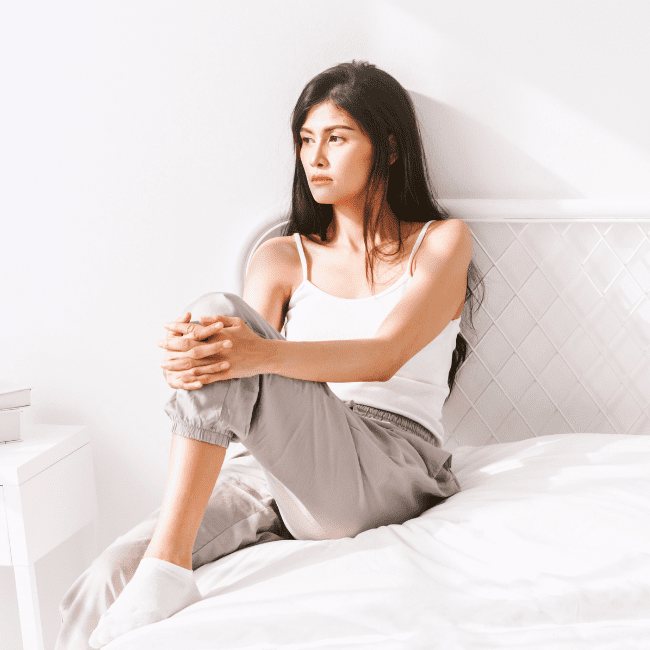When the days become shorter and the nights longer, many of us eagerly anticipate cozying up with a blanket, hot cocoa, and some of our favorite movies. But for some individuals, the change in seasons can bring about a shift in mood and energy levels, which isn't just a mere winter blues. This condition is known as Seasonal Affective Disorder (SAD), and it can have a significant impact on one's quality of life.
Some of the links in this post are affiliate links, meaning that if you click through and make a purchase, I will receive a small commission at no cost to you.
What is Seasonal Affective Disorder (SAD)?
Seasonal Affective Disorder (SAD) is a type of depression that comes and goes with the seasons, typically beginning in the late fall and early winter and going away during the spring and summer. [1] There are two types of SAD. While most people with SAD experience symptoms during these colder months, a smaller percentage experiences SAD during the summer months.
What Causes SAD?
The cause of SAD is not known with complete certainty. However, it is theoretically rooted in the interplay between light exposure, the pineal gland, and neurotransmitter activity. Reduced sunlight during shorter days of the year can disrupt the body's internal circadian rhythms (the body’s biological clock), which are intrinsically linked to the pineal gland's secretion of melatonin.[8] Melatonin, often referred to as the “sleep hormone”, has its production influenced by light; darkness stimulates its secretion, while light exposure suppresses it. In individuals with SAD, the extended duration of melatonin release during the longer nights can lead to altered sleep patterns and mood disturbances, leading to feelings of depression.
Additionally, decreased sunlight can lead to reduced levels of serotonin, a neurotransmitter crucial for mood regulation. Serotonin imbalances have been widely implicated in various forms of depression. Therefore, in SAD, the combination of disrupted circadian rhythms due to prolonged melatonin secretion and reduced serotonin levels contributes to the depressive symptoms that characterize this condition.
Symptoms of SAD may include:
- Feeling depressed most of the day, nearly every day
- Losing interest in activities you once enjoyed
- Changes in appetite or weight
- Difficulty sleeping or oversleeping
- Feeling sluggish or agitated
- Having difficulty concentrating
- Feeling hopeless, worthless, or guilty
- Thoughts of death or suicide

Best Products to Treat Seasonal Affective Disorder
For those experiencing SAD, there are various treatments available, many of which can be integrated seamlessly into your daily routine. Some of the most effective products include:
Light Therapy/SAD Lamps (Phototherapy): Probably the most well-known treatment for SAD, white light therapy involves sitting a few feet from a specialized light therapy box so that you're exposed to bright light. This mimics natural outdoor light and appears to cause a change in brain chemicals linked to mood. They offer the required 10,000 lux of light, which is about 20 times greater than regular indoor lighting, but without UV rays.
I am using a SAD lightbox as I am typing this. It has been a game changer for me and my seasonal affective disorder. It helps me feel less like sludge, dragging myself through each day. I use mine 20-30+ minutes a day for optimal results.
If you have Bipolar Disorder, consulting your physician before using light therapy is recommended as it can possibly trigger manic episodes. [2]
Verilux® HappyLight® Lucent – One-Touch Light Therapy Lamp with 10,000 Lux, UV-Free, LED Bright White Light & Detachable Stand for Boosting Mood & Improving Sleep
Red light therapy, distinct from the more commonly used bright white light therapy for Seasonal Affective Disorder (SAD), has gained interest in the realm of wellness and therapeutic treatments. While white light therapy aims to replicate the brightness of outdoor light and influence the brain's production of serotonin and melatonin, red light therapy operates on a different principle. It focuses on cellular rejuvenation and inflammation reduction. Some studies suggest potential mood-enhancing benefits due to improved cellular health and circulation, but it's important to note that as of now, red light therapy is not a standard or widely accepted treatment for SAD. More rigorous research is needed to establish its efficacy in treating mood disorders in comparison to traditional light therapies.[4]
Red-Light-Therapy, LED 660nm and Near Infrared 850nm Light Combo-Red Light Therapy Device for Face Body Skin
Dawn Simulators: These are devices that gradually increase the amount of light in your bedroom in the morning, mimicking the natural sunrise, which can help recalibrate your body's internal clock.[5] These make waking up in the pitch black, dark morning so much easier. It's the worst when you wake up and it's still dark out for hours. This lessens the winter blues with easing into your day with gradual gentle light.
Wake Up Light Sunrise Alarm Clock-This dawn simulator has almost 25000 reviews and a 4.3 star rating out of 5 at the time of publishing!
Negative Ion Generators: Some studies suggest that releasing negative ions into the air might benefit those with SAD. While the evidence is still being debated, some people claim to feel better when using these devices.[6] Clearly more research is needed, but this is certainly worth a shot as a possible treatment.
POMORON MJ002H 4-in-1 Air Purifiers for Home, H13 True Hepa Filter, Air Ionizer Negative Ion Generator and UV, Filter 0.3 Microns Particles Such As Smoke Dander Air Cleaner for Bedroom Office
Supplements: Vitamin D supplements are often recommended as it's believed that low levels might be linked to SAD.[7] However, always consult with a healthcare provider before starting any supplementation. I test my clients’ Vitamin D levels here at Wellness Refresh. You can schedule a discovery appointment and I will go over various recommendations with you. Additionally, sign up at my online pharmacy to buy Vitamin D supplements.
Additional Ways to Treat Seasonal Affective Disorder
Apart from products, several approaches can be taken to treat SAD:
Cognitive Behavioral Therapy (CBT): CBT can be tailored to treat SAD. This type of therapy helps identify and change negative thought patterns and behaviors that may be making you feel worse.
Medication: Some people with SAD benefit from antidepressant treatment. It's essential to consult a psychiatrist or primary care provider if you believe medication might be right for you.
Mind-Body Techniques: Yoga, tai chi, meditation, and music or art therapy may help reduce SAD symptoms. I am partial to Tai Chi as an effective treatment for light exercise and SAD. It's gentle on the joints (which is great for those of us with EDS or other joint issues).
Stay Active: Physical activity can help reduce depression symptoms. Ideally, first thing in the morning is preferred to gain similar results as light therapy. Double points if you can do your workouts in front of the lightbox! If first thing in the morning is not possible, consider taking walks during your lunch break or joining a winter sports league to get regular exercise.
Establish a Routine: Keeping a regular sleep schedule and staying active during the daytime can help regulate your circadian rhythm. As much as you would like to hibernate and binge watch your favorite shows while eating soup, curled up under a blanket, keeping a consistent schedule is incredibly important to ward off the winter blues.
Stay Connected: Engaging socially can serve as a counter to the isolation often felt during the winter months. Keep in touch with loved ones or consider joining a support group for people with SAD. Ok, so I'll admit it, this one can be tough for me as an introvert. But, making sure I connect even if it's through facetime, or in small doses, it really does help. So, peel yourself off of your couch and get out a mingle, if even for a little bit.
In conclusion, while Seasonal Affective Disorder can pose challenges to those affected, understanding its root causes and potential treatments can be empowering. If you or someone you know might be dealing with SAD, it's crucial to seek professional advice. Together with the right strategies and products, a happier, brighter winter season might be just around the corner!
Remember, every season is a new opportunity for growth and renewal. Join Wellness Refresh on Social Media with the icons below for more health tips and tricks. Or sign up for our weekly newsletter with Blog Posts covering a variety of helpful health topics.

References:
- Torres, F. (2020, October). Seasonal affective disorder (SAD). Psychiatry.org – Seasonal Affective Disorder (SAD). https://www.psychiatry.org/Patients-Families/Seasonal-Affective-Disorder
- Corliss, J. (2022, October 28). Light therapy: Not just for seasonal depression?. Harvard Health. https://www.health.harvard.edu/blog/light-therapy-not-just-for-seasonal-depression-202210282840
- Nussbaumer-Streit, et al., (2019, March). Light therapy for preventing seasonal affective disorder. The Cochrane database of systematic reviews. https://pubmed.ncbi.nlm.nih.gov/30883670/
- Cassano , et al. (2019, March). Review of Transcranial Photobiomodulation for major depressive disorder: Targeting brain metabolism, inflammation, oxidative stress, and neurogenesis. Neurophotonics. https://pubmed.ncbi.nlm.nih.gov/26989758/
- Danilenko, K., & Ivanova, I. (2019, July). Dawn simulation vs. bright light in seasonal affective disorder: Treatment effects and subjective preference. Journal of affective disorders. https://pubmed.ncbi.nlm.nih.gov/25885065/
- Perez, V., Alexander, D. D., & Bailey, W. H. (2013, January 15). Air ions and mood outcomes: A review and meta-analysis. BMC psychiatry. https://www.ncbi.nlm.nih.gov/pmc/articles/PMC3598548/
- Melrose, S. (2015). Seasonal affective disorder: An overview of assessment and treatment approaches. Depression research and treatment. https://www.ncbi.nlm.nih.gov/pmc/articles/PMC4673349/#B10
- Patrick Bigaouette, M. D. (2023, January 5). Seasonal affective disorder: Not just the winter blues. Mayo Clinic Health System. https://www.mayoclinichealthsystem.org/hometown-health/speaking-of-health/seasonal-affective-disorder-not-just-the-winter-blues





